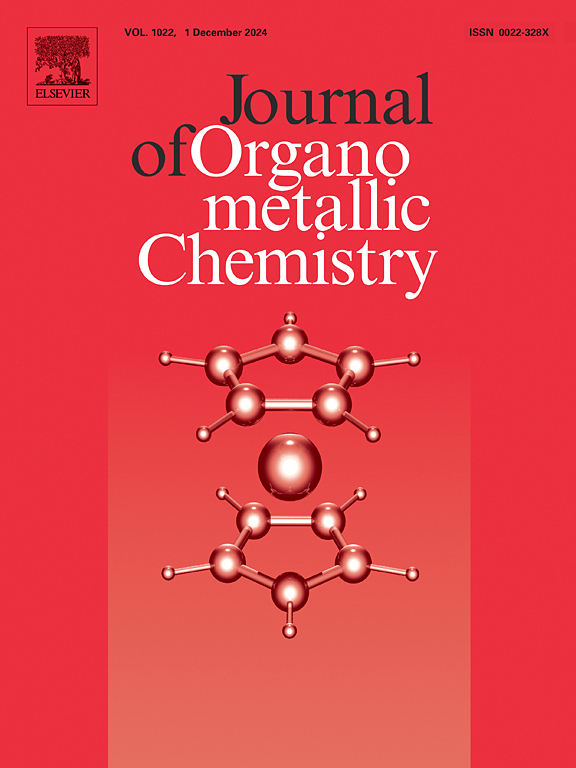Star-shaped trinuclear organometallic complexes with a benzo[1,2-b:3,4-b′:5,6-b′′]trithiophene triethynyl backbone: Syntheses, (spectro-)electrochemistry, and theoretical calculations
IF 2.1
3区 化学
Q3 CHEMISTRY, INORGANIC & NUCLEAR
引用次数: 0
Abstract
The two star-shaped trimetal ethynyl complexes benzo[1,2-b:3,4-b':5,6-b'']trithiophene (BTT)][MCp*(dppe)2]3 (3, M = Ru; 4, M = Fe) are synthesized and characterized by NMR spectroscopy, elemental analysis and X-ray single crystal diffraction. The influence of different metals linked with identical bridge core on the electronic properties of 3 and 4 under various redox states are studied using electrochemical (cyclic and square wave voltammetry) and spectroelectrochemical (in situ UV-Vis-NIR and IR spectroscopy) methods and DFT calculations. Cyclic voltammetry experiments of 3 and 4 have evidenced weak electronic interaction among three terminal groups. Gradual oxidation processes of 3 and 4 characterized by IR and UV-Vis-NIR spectra changes feature small ν(C![]() C) shifts and also don't lead to the appearance of broad NIR absorptions, which implied that only weak communication exists in the mixed-valent forms. In addition, probing the electronic structure of neutral molecules 3 and 4 and corresponding singly-oxidized species by DFT calculations including spin density distributions confirmed effectively the dominant bridge-localized oxidation characteristics.
C) shifts and also don't lead to the appearance of broad NIR absorptions, which implied that only weak communication exists in the mixed-valent forms. In addition, probing the electronic structure of neutral molecules 3 and 4 and corresponding singly-oxidized species by DFT calculations including spin density distributions confirmed effectively the dominant bridge-localized oxidation characteristics.

具有苯并[1,2-b:3,4-b ':5,6-b ']三噻吩三乙基骨架的星形三核有机金属配合物:合成、(光谱)电化学和理论计算
两个星形三金属乙基配合物苯并[1,2-b:3,4-b':5,6-b']三噻吩(BTT)][MCp*(dppe)2]3 (3, M = Ru;4, M = Fe)的合成,并通过核磁共振、元素分析和x射线单晶衍射进行了表征。采用电化学(循环伏安法和方波伏安法)和光谱电化学(原位紫外-可见-近红外光谱法和红外光谱法)方法和DFT计算,研究了与相同桥芯连接的不同金属对不同氧化还原状态下3和4电子性质的影响。3和4的循环伏安实验证明了三个末端基团之间的弱电子相互作用。红外光谱和紫外-可见-近红外光谱变化表征的3和4的逐渐氧化过程具有较小的ν(CC)位移,也没有导致广泛的近红外吸收,这意味着在混合价态中只存在弱通信。此外,通过DFT计算(包括自旋密度分布)探测中性分子3和4以及相应的单氧化物质的电子结构,有效地证实了主要的桥定域氧化特征。
本文章由计算机程序翻译,如有差异,请以英文原文为准。
求助全文
约1分钟内获得全文
求助全文
来源期刊

Journal of Organometallic Chemistry
化学-无机化学与核化学
CiteScore
4.40
自引率
8.70%
发文量
221
审稿时长
36 days
期刊介绍:
The Journal of Organometallic Chemistry targets original papers dealing with theoretical aspects, structural chemistry, synthesis, physical and chemical properties (including reaction mechanisms), and practical applications of organometallic compounds.
Organometallic compounds are defined as compounds that contain metal - carbon bonds. The term metal includes all alkali and alkaline earth metals, all transition metals and the lanthanides and actinides in the Periodic Table. Metalloids including the elements in Group 13 and the heavier members of the Groups 14 - 16 are also included. The term chemistry includes syntheses, characterizations and reaction chemistry of all such compounds. Research reports based on use of organometallic complexes in bioorganometallic chemistry, medicine, material sciences, homogeneous catalysis and energy conversion are also welcome.
The scope of the journal has been enlarged to encompass important research on organometallic complexes in bioorganometallic chemistry and material sciences, and of heavier main group elements in organometallic chemistry. The journal also publishes review articles, short communications and notes.
 求助内容:
求助内容: 应助结果提醒方式:
应助结果提醒方式:


